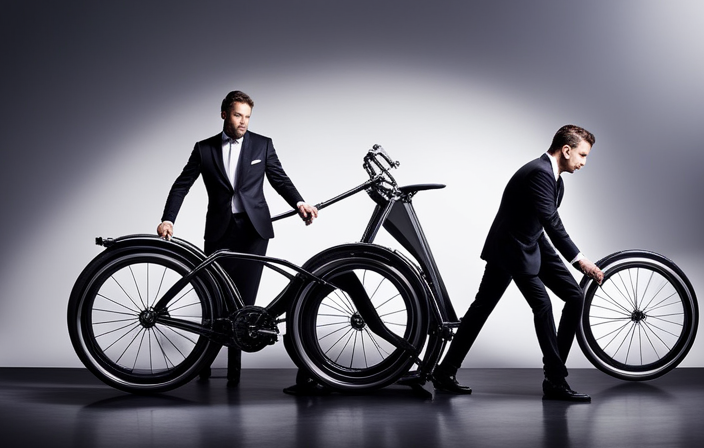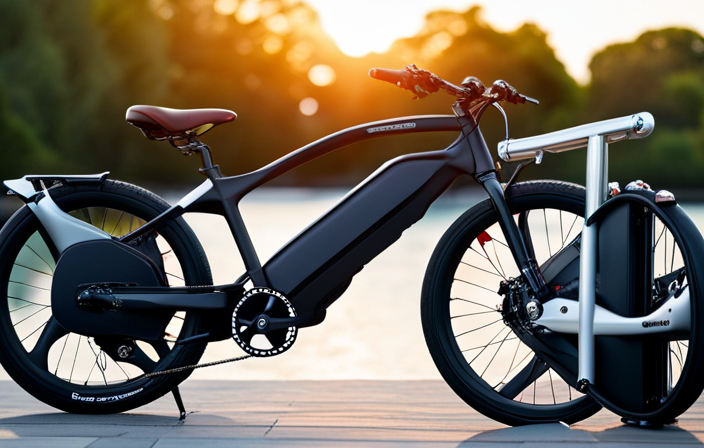Are you a fan of electric bikes wanting to learn about the lifespan of your batteries during your exciting rides? Similar to the fuel tank of a car, electric bike batteries are crucial for providing power to your two-wheeled friend.
In this article, we will dive into the world of electric bike batteries, exploring different types, factors that influence their lifespan, signs of degradation, and how to extend their longevity.
So buckle up and get ready to unlock the secrets of electric bike battery longevity!
Key Takeaways
- Regular charging and discharging, as well as avoiding extreme temperatures, can help prolong battery life.
- Proper battery selection and maintenance can maximize lifespan.
- Decreased range is a common sign of a degrading battery.
- Longer charging times may indicate battery degradation.
Types of Electric Bike Batteries
How long do electric bike batteries last? Well, it depends on the type of battery you have. When it comes to electric bike batteries, there are several types to choose from, each with its own lifespan.
The most common types are lead-acid, nickel-cadmium (NiCad), nickel-metal hydride (NiMH), and lithium-ion (Li-ion) batteries. Battery maintenance plays a crucial role in extending their lifespan. Regularly charging and discharging the battery, as well as avoiding extreme temperatures, can help prolong its life.
Additionally, choosing the right battery for your electric bike is essential. Consider factors such as weight, power output, and expected range. By selecting the appropriate battery type and maintaining it properly, you can maximize its lifespan.
Moving on to factors affecting battery lifespan, let’s explore how usage patterns and environmental conditions can impact the longevity of your electric bike battery.
Factors Affecting Battery Lifespan
To maximize battery lifespan, you’ll want to consider various factors. Proper battery maintenance is crucial in ensuring a long-lasting battery. Regularly charging and discharging your battery, as well as avoiding deep discharges, can significantly extend its life.
Additionally, keeping your battery at the right temperature is essential. Extreme heat or cold can have a negative impact on battery performance and longevity. It is recommended to store your electric bike in a cool and dry place, away from direct sunlight and freezing temperatures. When riding in extreme weather conditions, try to keep the battery within its optimal temperature range.
By taking these steps, you can ensure that your battery lasts as long as possible, providing you with many enjoyable rides.
Now let’s delve into the average lifespan of electric bike batteries.
Average Lifespan of Electric Bike Batteries
The average lifespan of e-bike batteries can vary depending on various factors, such as usage patterns and maintenance practices. To ensure the longevity of your electric bike battery, consider the following tips:
-
Proper charging: Avoid overcharging or completely draining the battery. Ideally, charge it to 80% and avoid leaving it plugged in overnight.
-
Storage conditions: Store the battery in a cool, dry place, away from extreme temperatures and direct sunlight.
-
Regular maintenance: Clean the battery terminals regularly and check for any signs of damage or corrosion.
By following these battery maintenance tips, you can maximize the lifespan of your electric bike battery and prevent common battery issues.
Now, let’s explore the signs of a degrading battery in the next section.
Signs of a Degrading Battery
When it comes to identifying signs of a degrading electric bike battery, there are a few key indicators to look out for.
Firstly, you may notice a decreased range, meaning your bike won’t be able to travel as far on a single charge as it used to.
Secondly, you may experience longer charging times, as the battery takes longer to reach a full charge.
Lastly, you may observe increased battery heating, which can be a sign of internal degradation and reduced overall performance.
Decreased Range
Although electric bike batteries can last for several years, their range may decrease over time. This decrease in range is often caused by a decrease in battery capacity.
As the battery ages, it may not be able to hold as much charge as it once could, resulting in a shorter distance that can be traveled on a single charge. To mitigate this issue, it is important to properly maintain the battery.
Regularly charging and discharging the battery can help prolong its lifespan and maintain its capacity. Additionally, storing the battery at a moderate temperature and avoiding extreme heat or cold can also help preserve its performance.
However, despite these efforts, it is inevitable that the range will decrease as the battery ages. This decrease in range can be frustrating for riders, but it can be managed by planning for longer charging times.
Longer Charging Times
To ensure that your e-bike is fully charged, you may need to plan for extended charging periods. This is because longer charging times have become a common issue for electric bikes due to increased energy consumption. The impact on cycling performance can be significant, as longer charging times mean less time on the road.
In order to address this issue, manufacturers have implemented certain measures to minimize the impact. These include the development of fast-charging technologies, such as quick charge adapters and high-capacity chargers. Additionally, some e-bike models now feature removable batteries, allowing you to easily swap out a depleted battery for a fully charged one. Finally, advancements in battery management systems have improved overall charging efficiency, reducing the time it takes to fully charge your e-bike.
As we move on to the next section about increased battery heating, it is important to understand how longer charging times can affect the overall performance and lifespan of your e-bike battery.
Increased Battery Heating
As we discussed in the previous section, longer charging times can be a concern when it comes to electric bike batteries.
Now, let’s delve into another issue that can arise with battery usage – increased battery heating. When an electric bike battery gets hot, it can negatively impact its overall performance and lifespan. Excessive heat can cause the battery to degrade faster and lose its capacity over time.
To mitigate this issue, manufacturers have implemented various battery cooling methods, such as using cooling fans or heat sinks. These methods help dissipate the heat generated during usage and prevent overheating. By effectively managing battery temperature, the performance and longevity of the battery can be significantly improved.
Now, let’s explore how to extend the lifespan of your electric bike battery without compromising its performance and efficiency.
How to Extend Battery Lifespan
If you want to extend your battery lifespan, you should make sure to properly store and charge it. Maximizing battery performance requires following best practices for battery care.
First, it is crucial to store your electric bike battery in a cool and dry place, away from extreme temperatures or direct sunlight. This helps prevent overheating and reduces the risk of damage to the battery cells.
Additionally, when charging your battery, it is important to use the charger provided by the manufacturer and avoid overcharging or leaving it plugged in for extended periods. Regularly checking the battery’s charge level and avoiding deep discharges can also help prolong its lifespan.
By following these guidelines, you can ensure optimal battery health and performance.
Now, let’s explore the various battery replacement options available for electric bikes.
Battery Replacement Options
When it comes time to replace your battery, you have several options to choose from.
One option is to check if your electric bike battery is still covered under warranty. Many manufacturers offer battery warranty options that can provide you with a replacement battery at little to no cost. It is important to review the terms and conditions of the warranty to understand what is covered and for how long.
Another option is to explore battery recycling programs. These programs allow you to dispose of your old battery in an environmentally friendly way. Some programs even offer incentives, such as discounts on new batteries, when you recycle your old one.
By considering these options, you can find a solution that suits your needs and helps you get the most out of your electric bike.
Frequently Asked Questions
Can I replace my electric bike battery with a higher capacity one?
Yes, you can replace your electric bike battery with a higher capacity one. Upgrading to a higher capacity battery offers advantages such as longer range and increased power, but it may also have disadvantages like added weight and higher cost.
Are there any specific maintenance tips to prolong the lifespan of an electric bike battery?
To prolong the lifespan of your electric bike battery, follow these maintenance tips: avoid extreme temperatures, store it in a cool and dry place, charge it regularly, and avoid overcharging. Watch out for common signs of a deteriorating battery, such as reduced range and decreased power.
How long does it typically take to fully charge an electric bike battery?
You’re probably wondering how long it takes to fully charge an electric bike battery. Factors like battery capacity, charger power, and voltage can affect charging time. Fast charging options are available for some electric bike batteries.
Is it possible to upgrade the battery on an existing electric bike model?
Yes, it is possible to upgrade the battery on an existing electric bike model. Upgrading the battery can significantly improve the performance of your electric bike, providing longer range, increased power, and a more enjoyable riding experience.
Can I use a different brand of battery for my electric bike if the original one is no longer available?
Yes, you can use an alternative battery for your electric bike if the original one is no longer available. However, compatibility issues may arise, so it’s crucial to ensure that the replacement battery matches the required specifications of your electric bike.
Conclusion
In conclusion, the lifespan of electric bike batteries depends on various factors such as battery type, usage patterns, and maintenance. Regularly monitoring the health of your battery is crucial to ensure optimal performance.
If you notice signs of degradation like reduced range or slower charging, it’s time to consider battery replacement.
Remember, treating your battery with care and following recommended charging practices can significantly extend its lifespan, allowing you to pedal through the electric bike journey smoothly for miles and miles. Avoid overcharging or fully depleting the battery, as both can reduce its efficiency over time. Keeping an eye on your electric bike charger power usage ensures that you’re not wasting energy while maintaining optimal battery health. Proper storage in a cool, dry place also helps preserve battery performance for longer rides.
















